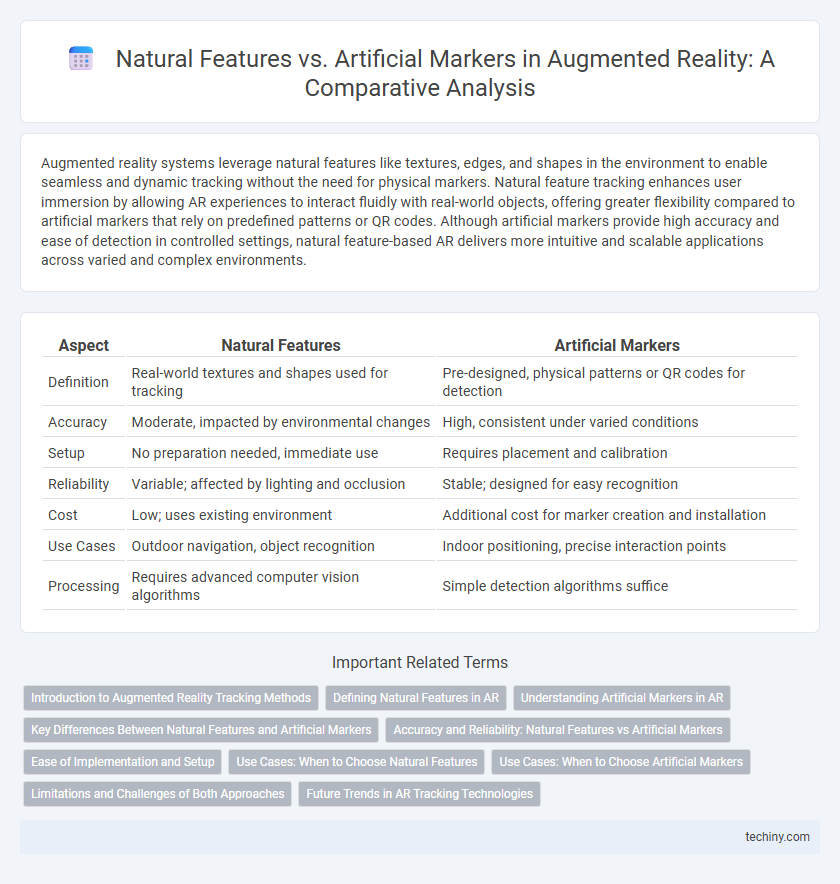Augmented reality systems leverage natural features like textures, edges, and shapes in the environment to enable seamless and dynamic tracking without the need for physical markers. Natural feature tracking enhances user immersion by allowing AR experiences to interact fluidly with real-world objects, offering greater flexibility compared to artificial markers that rely on predefined patterns or QR codes. Although artificial markers provide high accuracy and ease of detection in controlled settings, natural feature-based AR delivers more intuitive and scalable applications across varied and complex environments.
Table of Comparison
| Aspect | Natural Features | Artificial Markers |
|---|---|---|
| Definition | Real-world textures and shapes used for tracking | Pre-designed, physical patterns or QR codes for detection |
| Accuracy | Moderate, impacted by environmental changes | High, consistent under varied conditions |
| Setup | No preparation needed, immediate use | Requires placement and calibration |
| Reliability | Variable; affected by lighting and occlusion | Stable; designed for easy recognition |
| Cost | Low; uses existing environment | Additional cost for marker creation and installation |
| Use Cases | Outdoor navigation, object recognition | Indoor positioning, precise interaction points |
| Processing | Requires advanced computer vision algorithms | Simple detection algorithms suffice |
Introduction to Augmented Reality Tracking Methods
Augmented reality tracking methods rely on natural features or artificial markers to accurately overlay virtual content onto the physical world. Natural feature tracking uses environmental elements like edges, textures, and patterns detected by computer vision algorithms, enabling markerless AR experiences in diverse, unprepared environments. Artificial markers involve predefined symbols or QR codes, providing high precision and reliability but requiring prior placement, which limits flexibility compared to natural feature-based methods.
Defining Natural Features in AR
Natural features in augmented reality (AR) are distinct, consistent elements found naturally within the environment, such as edges, textures, and corners of objects like trees, rocks, or buildings, used for tracking and overlaying digital content. These intrinsic environmental cues enable AR systems to anchor virtual objects accurately without requiring external physical markers. Leveraging natural features enhances user experience by providing seamless integration of digital elements within real-world scenes, improving spatial awareness and interaction fidelity.
Understanding Artificial Markers in AR
Artificial markers in augmented reality are predefined patterns or symbols designed to be easily recognized by AR devices, enabling precise tracking and alignment of virtual content within a physical environment. These markers, such as QR codes or fiducial markers, provide consistent reference points that enhance the accuracy and stability of AR experiences compared to natural features, which rely on environmental textures and shapes. Understanding the functionality and deployment of artificial markers is crucial for developers aiming to optimize AR applications in controlled settings requiring reliable detection and minimal computational overhead.
Key Differences Between Natural Features and Artificial Markers
Natural features in augmented reality rely on inherent environmental elements like textures, edges, and shapes for tracking, ensuring seamless integration without physical alterations. Artificial markers are predefined visual symbols designed to be easily recognized by AR devices, offering higher precision and reliability in controlled settings. The key difference lies in natural features providing an unobtrusive user experience, while artificial markers guarantee consistent tracking accuracy.
Accuracy and Reliability: Natural Features vs Artificial Markers
Natural features in augmented reality leverage real-world textures and objects for tracking, offering high environmental integration but can suffer from variability due to lighting and occlusion. Artificial markers provide consistent accuracy and reliability, as they are designed for easy detection and stable tracking, minimizing errors in diverse conditions. Comparing both, artificial markers excel in controlled environments, whereas natural feature detection offers flexibility but may require advanced algorithms to maintain precision.
Ease of Implementation and Setup
Natural features in augmented reality leverage existing environmental elements like textures and edges, enabling quick setup without extra physical components. Artificial markers require printing and placement, increasing preparation time but offering more reliable tracking in controlled settings. Ease of implementation depends on application needs, with natural features favored for rapid deployment and artificial markers preferred for precision.
Use Cases: When to Choose Natural Features
Natural features in augmented reality are ideal for outdoor navigation, real-world object recognition, and environmental interaction where infrastructure is limited. These features enable seamless integration by utilizing textures, edges, and shapes of the environment, enhancing user experience in tourism, gaming, and industrial maintenance. Choosing natural features is beneficial in dynamic, unstructured settings where artificial markers would be impractical or intrusive.
Use Cases: When to Choose Artificial Markers
Artificial markers excel in environments with poor natural feature density, such as indoor settings or minimalist spaces, ensuring reliable tracking and precise alignment. Use cases like industrial maintenance, detailed assembly instructions, and interactive museum exhibits benefit from their consistent detection and stability. Their predefined patterns enable faster initialization and reduce tracking errors compared to natural feature-based AR.
Limitations and Challenges of Both Approaches
Natural feature tracking in augmented reality faces challenges such as inconsistent lighting conditions, complex backgrounds, and limited scalability in dynamic environments. Artificial markers provide reliable detection and precise positioning but suffer from reduced aesthetic appeal and dependency on marker visibility and placement. Both methods require balancing robustness and user experience, with ongoing research aimed at improving adaptability and accuracy in diverse scenarios.
Future Trends in AR Tracking Technologies
Future trends in AR tracking technologies emphasize the integration of advanced machine learning algorithms to enhance natural feature recognition, enabling seamless interaction with complex real-world environments. Developments in sensor fusion and computer vision improve accuracy and robustness in markerless tracking, reducing dependency on artificial markers for scalable and intuitive AR experiences. Enhanced spatial mapping and real-time environment understanding pave the way for more immersive applications across industries such as gaming, education, and industrial maintenance.
Natural Features vs Artificial Markers Infographic

 techiny.com
techiny.com